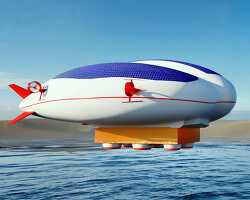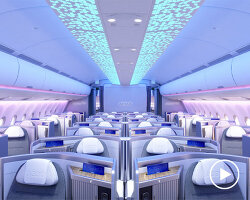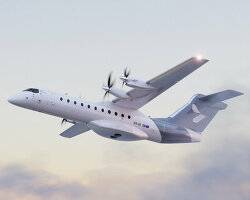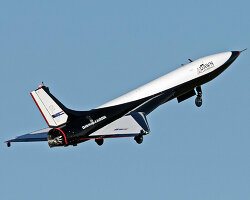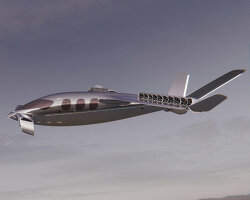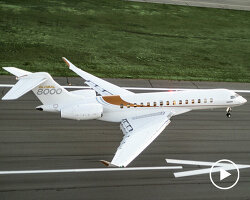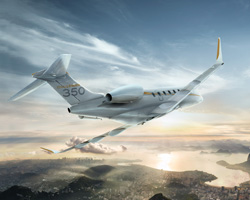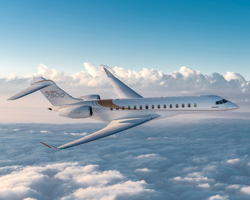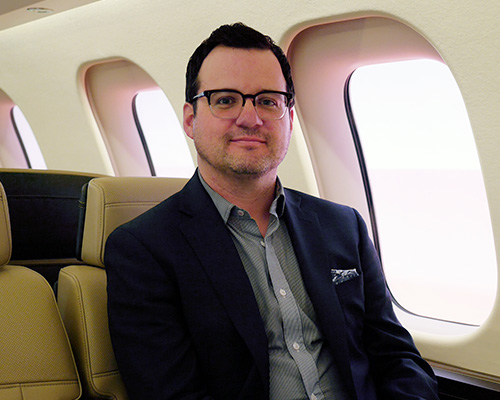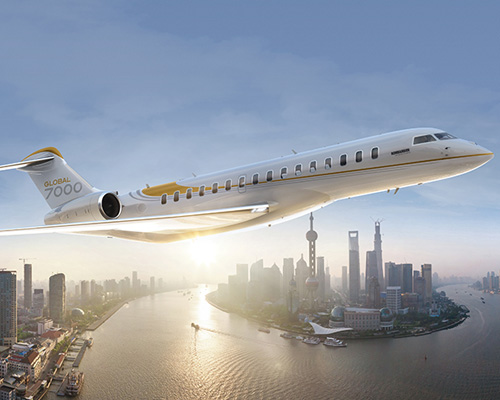few design projects are as monumental in scale and scope as the design of an aircraft — particularly when it’s the largest and longest range business jet to ever take to the skies. tim fagan is the head of industrial design at bombardier business aircraft, and is preparing for the industry’s new flagship — the global 7500 — to be entered into service later this year. fagan and his team have spent years on the design and development of the global 7500, working passionately on numerous aspects of the cabin experience, from lighting, to seating, and entertainment spaces. keeping bombardier’s ‘exceptional by design’ philosophy close at hand, the industrial design team have led a ‘no compromise’ approach across the execution of the project, realizing a truly extraordinary aircraft that has revolutionized the aviation industry.
designboom spoke in-depth with fagan about the evolution of bombardier’s global 7500 as a design project, the most important elements of designing for aerospace, and the vision behind the ‘home in the sky’.
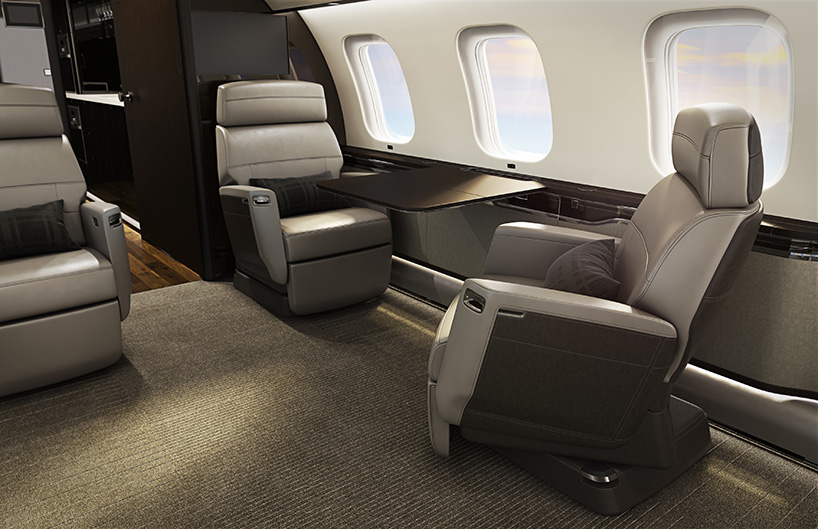
the global 7500 cabin has been conceived as ‘a home or office in the sky’
designboom (DB): can you start by explaining your role at bombardier, and your team’s primary focus?
tim fagan (TF): I’m the industrial design manager at bombardier business aircraft. our team was put together in 2011 to focus on the design and development of the global 7000 — now the global 7500. our intention was to focus specifically on cabin experience: cabin layout, variability, seating, cabin management, connectivity, and the different types of furnishings we offer inside the cabin. these are the elements that have a really strong impact on passenger experience on-board the aircraft. we got involved in helping develop the airframe to make sure that things like the length of the aircraft cabin, and the placement and size of the windows were just right, and were going to be a perfect match at the end for our intent within the cabin.
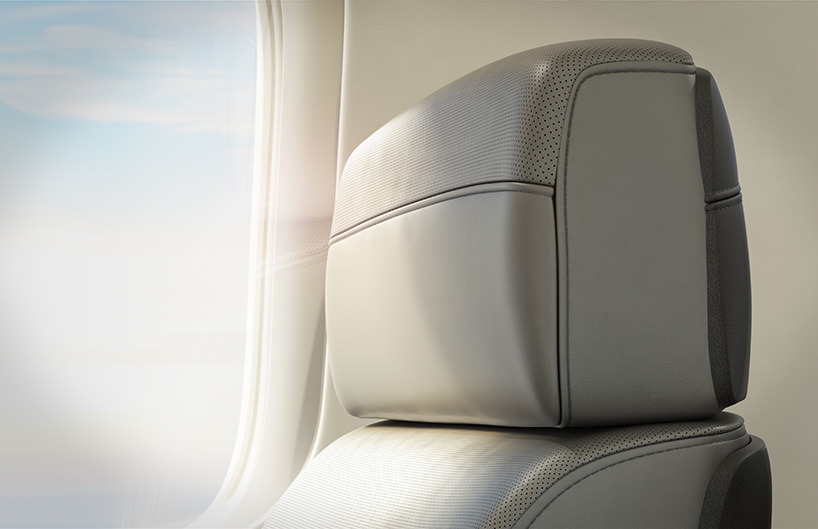
the ‘nuage’ seat represents the first meaningful change in the design of a business aircraft seat in 30 years
DB: how has the global 7500 evolved from the global 7000?
TF: the global 7500 is a new name that we announced earlier this year linked specifically to a range increase and a performance increase from the original aircraft. this range extension of an additional 300 nautical miles was made possible thanks to the expertise of our engineers to manage the aircraft configuration as well as the positive results of our flight testing program — something we’re super excited about! that means more performance and capability for the people that are using the aircraft. what we’ve got is the largest, and longest range purpose-built business jet with four cabin suites, and the only aircraft that can fly between new york and hong kong, for example, non-stop.
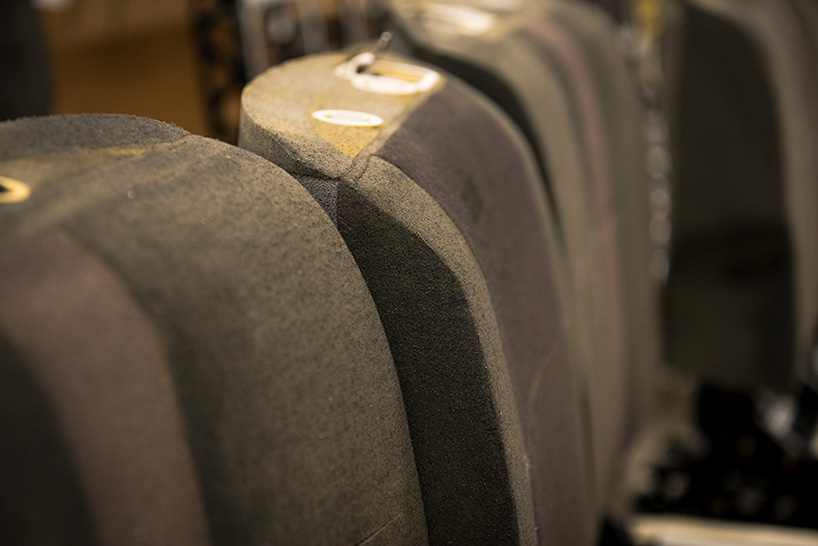
‘nuage’ seats are sculpted by hand at bombardier’s state-of-the-art centre of excellence in montréal
DB: where did it all begin?
TF: we started with the idea of a ‘no compromise’ cabin. the global 7500 is a 16 hour aircraft, and you’re going to be traveling around the globe and crossing time zones. our clients could be traveling for business or with their families. they might want to prioritize maximum passengers, or the efficiency of connectivity and the business environment. to find all of the things you’d expect from your home and office environment, and arrive at your destination refreshed and ready to go, was a very important consideration. we wanted to make sure that we offered a range of cabin layouts and options that would let our customers configure the aircraft to their particular needs.
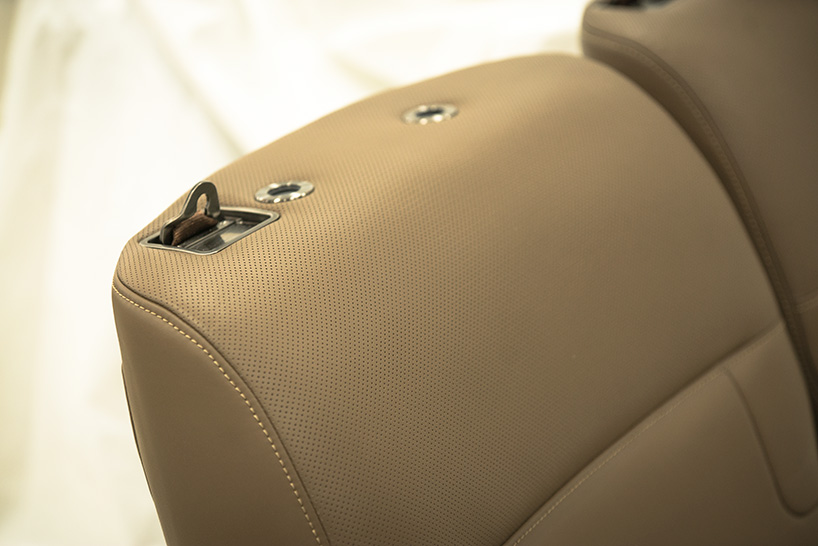
a team of master craftspeople are responsible for high-precision, upholstery and leather completion work
DB: how does the vision for the global 7500 embody bombardier’s ‘exceptional by design’ philosophy?
TF: we wanted to take our motto of ‘exceptional by design’ and make that a reality inside the cabin, and what that means is ‘no compromise’. we looked at all the ways that passengers will use the aircraft. a long-range aircraft involves sleeping: how do we create an amazing bedroom, with perfect lighting, considered amenities and a welcoming bed so that passengers can arrive completely refreshed at their destination? how management can conduct a board room meeting at 51,000 feet or video conference as they would back in the office? how do we make sure that passengers can connect with loved ones back home, and facetime with the kids before bed? how do we ensure that seating is delivering the kind of comfort that allows passengers to be refreshed and comfortable all the way through their flight? how do we create an entertainment suite that allows passengers to relax and catch up on their favorite episodes just like they would at home? the idea of ‘no compromise’ really became part of the DNA of the aircraft.
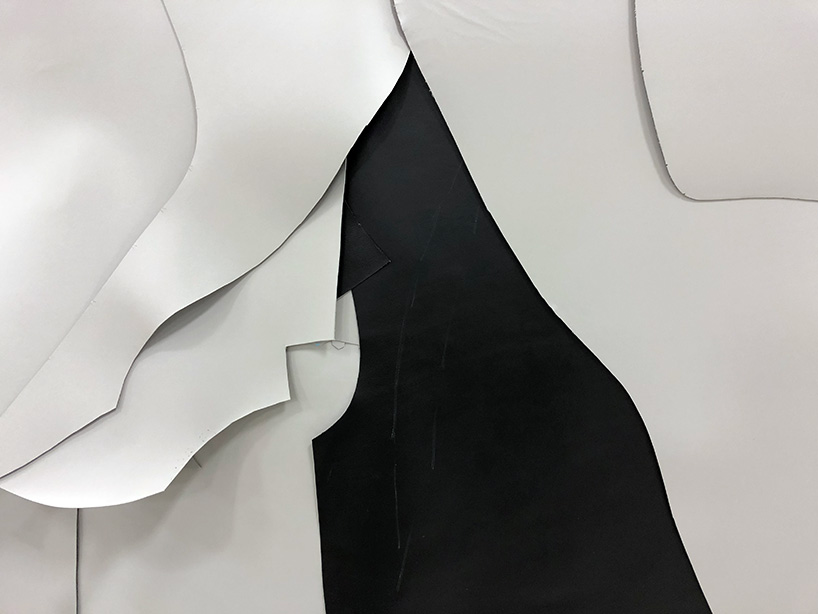
only the highest quality sheets of leather are selected for use on the ‘nuage’ seat
DB: what is the general timeline like on a design project as immense as this?
TF: the process of developing a clean sheet airplane from scratch takes several years. very early on through preliminary sketches, we develop concepts to figure out how we want the aircraft to be laid out, what the correct dimensions for cabin length should be, and where we want the windows to be located. through a series of mockups and collaborations with the airframe and engineering teams, we help figure out the proportions and dimensions of the aircraft, so that at the end, we know that the aircraft is tailor made to the requirements of what’s happening inside the passenger cabin.
the development phases for the interior gradually get more intensive with engineering and prototyping for every system on-board the aircraft — seating, lighting, cabinetry, connectivity, and the cabin management system. all of these elements are refined through increasingly-detailed mockups and prototypes that are tested physically by our engineering teams. we also reach out to customers and clients along the way to make sure that we have the benefit of their feedback and their knowledge. then, there’s ultimately the testing and certification process that’s required for all new aircraft. overall as a design team, iteration, mocking-up, and designing through experience is a huge part of what we do.
DB: how closely do you and your team work with engineers throughout the process to ensure that what you want to do is technically feasible?
TF: a very important part of our design process is collaboration — collaboration between the industrial design team, the customer-facing team, the engineering team, the manufacturing team and some of our supporting suppliers to make sure that we’re meeting all of the requirements we have. there are certainly engineering requirements, like weight, reliability, safety, and manufacturability. it’s super important to have these cross-functional teams come together so that we can all have the benefit of sharing our intent and collectively coming up with a solution that meets all the technical needs while still delivering a high-level customer experience.
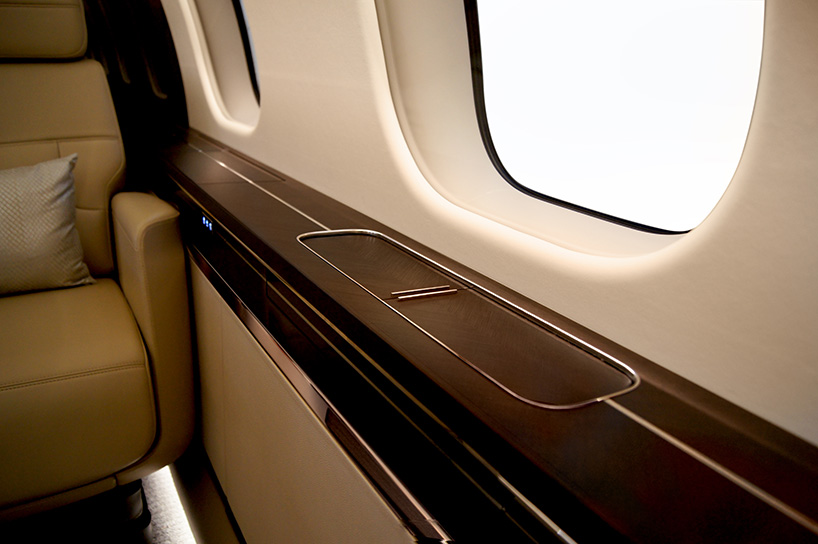
the interior design team drew from the latest in architecture and automotive design as sources of inspiration
DB: what is the primary design concept behind the global 7500?
TF: for the global 7500, the aim was to design a home in the sky, or an office in the sky, for our passengers and clients. the way to do that is to look at each cabin suite on its own, as you would in a home. when we’re designing a bedroom for example, the design team might be inspired by boutique hotels. we look at how you’d create a sense of coziness and a sense of calm in a space that size. we also think about what you need from a lighting point of view, and those little areas tucked away where you might put your personal items, like glasses. when we’re looking at an entertainment space, we gather information about what the correct screen size is, and the emerging technologies that our passengers are going to expect on-board the aircraft. certain things are very important, and require mocking-up and experimentation, such as sight lines, or the correct height and width for a screen within an aircraft environment. we think about stereo systems, surround sound systems, or lighting that might complement an entertainment space. wherever there’s excellence in home theater or bedroom design, or seating for example, we have specialist designers do that research and bring what’s best in those different areas back into the aircraft.
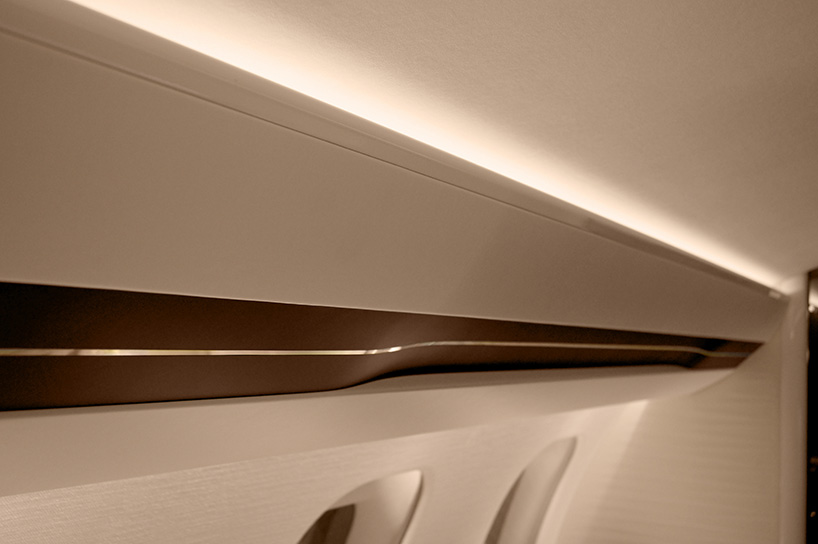
special materials used in aviation offer a high quality wood finish yet are extremely light weight
DB: how can passengers utilize the four true living spaces on-board, and how did the design process for those zones take shape?
TF: we designed the four zones based on experience. for example, we have a dedicated bedroom space that has a bed and perhaps a seat and an office setup. we’re looking at what clients might want in that realm. there are other areas, such as conference and dining areas, where there’s a different directive we’re trying to achieve — maybe to get a maximum number of seats inside for passengers to gather, work, or share a meal. each one of the requirements and experiences drives the result. another example is lighting. lighting that you want in a bedroom is different than what you might want at a dining table, which might later convert into a boardroom table. it’s super important for us to go through some of these experience points and try to imagine what customers and passengers on-board the aircraft might want. each one these experiences has a unique set of requirements that the design team looks at to make sure that all of the cabin suites are well defined.
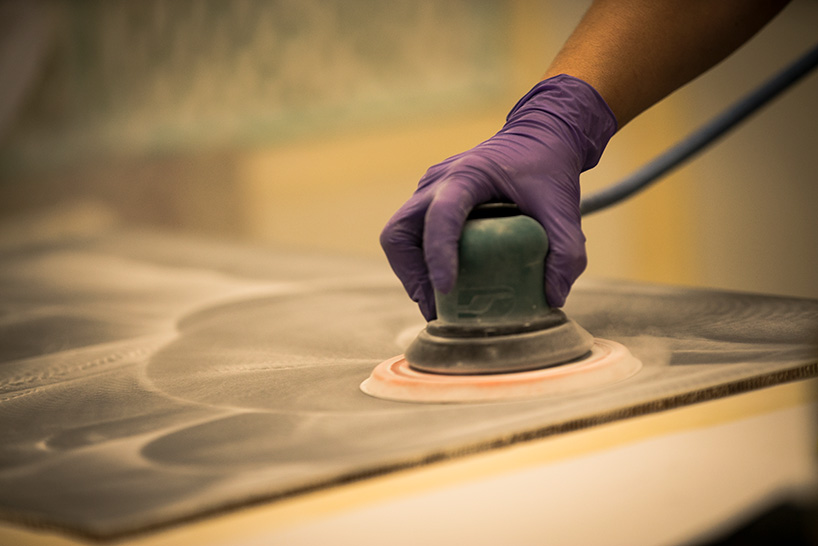
despite the machinery used to produce the aircraft, a human touch is present throughout the process
DB: how did natural light play a role in shaping the design and layout of the cabin?
TF: natural light is an extremely important part of creating a sense of well-being on-board. on the global 7500, we have huge windows. they’re carefully placed to maximize sight lines outside the aircraft and downwards, so that passengers can check out the terrain as they fly from place to place. we have a window at every seated position, and one centered at every table. we also needed to take into consideration that the aircraft is going to be crossing time zones, so we’ve integrated a very interesting and capable lighting system inside the cabin that allows passengers to create presets. for example, if they like a particular lighting color or temperature scenario for their work, they can save that, and the aircraft will remember it — and next time, they can easily go to that setting. we also have very cool daylight simulation technology in the aircraft. the aircraft and lighting system recognize where passengers are going and the time at the destination, and can blend passengers into the time zone. say you’re heading from new york to hong kong — do you want to maximize your sleep? do you want to get work done? we looked at how best to adjust the light intensity and color, so that when they arrive, they feel like they’re naturally blending into the time of day at the destination.
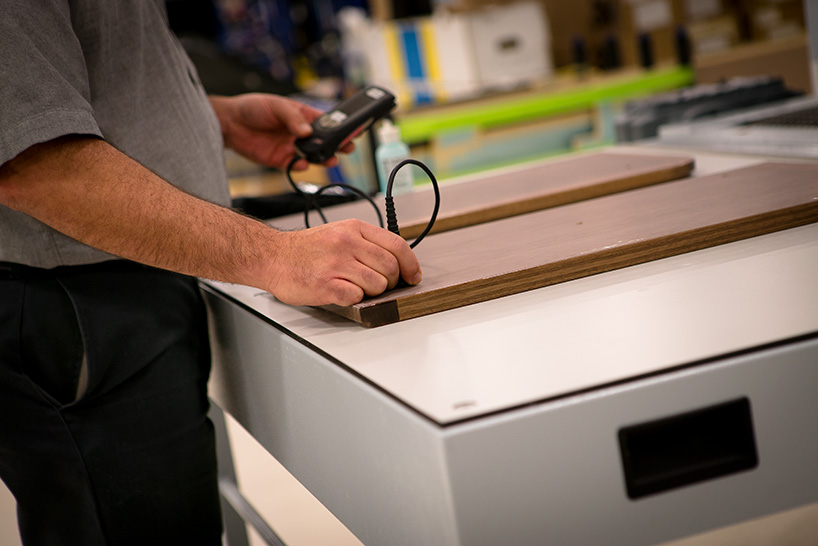
a highly skilled team of staff carefully monitors the progress of each component
DB: let’s dig deep into the design of the ‘nuage’ seat — what’s being called the most comfortable seat in aviation…
TF: the ‘nuage’ seat is a very important part of the global 7500 — that’s where passengers spend most of their time on-board the aircraft. we saw that as an opportunity to improve comfort and improve well-being. we started the seat development by looking into the different modes of the seat as it would be used in flight. a typical aircraft seat could be used as a dining seat, or a work seat in an upright configuration. during the flight, passengers might want to recline and relax to watch a movie, or do a little bit of reading, and later convert the seat into a bed. in our homes, each of these are separate pieces of furniture. the first thing we needed to do was to consider these elements and determine what the correct geometry for an upright position, or a recline position, would be — one that captures the maximum human demographic from the 5th to 95th percentile of users. we also looked at how we transition from that upright position to the recline position. we started with a blank slate and began with simple mockups, in some cases made from ordinary materials like wood and foam to help us dial in the correct geometry of these fixed positions. then, as we got more and more in depth, we started developing mechanical linkages that would transition the seat from the upright position to the deep recline position. we knew how we wanted the seat to feel, and the mechanisms to make that happen were baked into the engineering process right from the beginning.
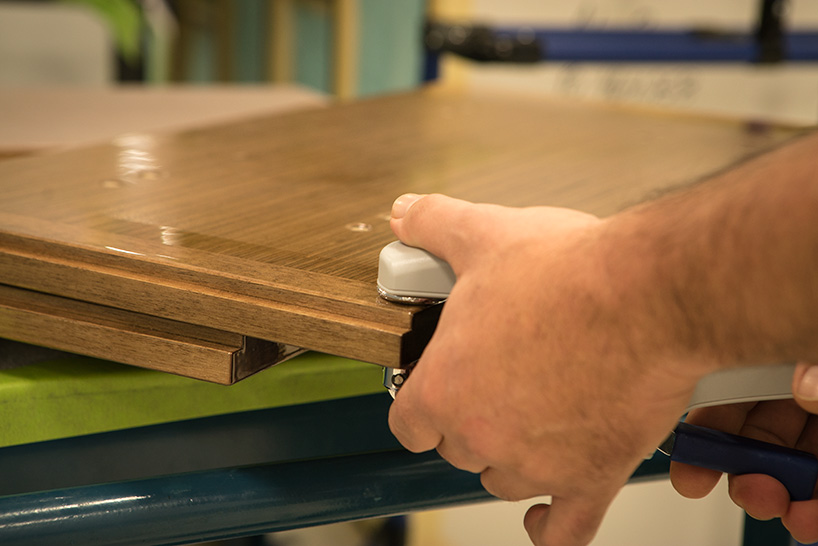
all materials used on-board are remarkably lightweight
DB: how does it feel to sit in the ‘nuage’ seat? what are its key features?
TF: some of the more notable things you’ll see in the ‘nuage’ seat are linked to human geometry — how people move around within a seat, and how people behave while they’re sitting. the first element is what we call the ‘floating base’. the mechanism that allows you to move the single seats around the cabin — to get closer to the table, or to rotate to speak to someone next to you — has been redesigned to make it smooth, effortless and completely silent. we’ve also relocated the point of rotation directly underneath the seat pan, so that as you move around the cabin, the point of rotation is always directly below your center of gravity. it’s a subtle change, but it feels very natural and intuitive.
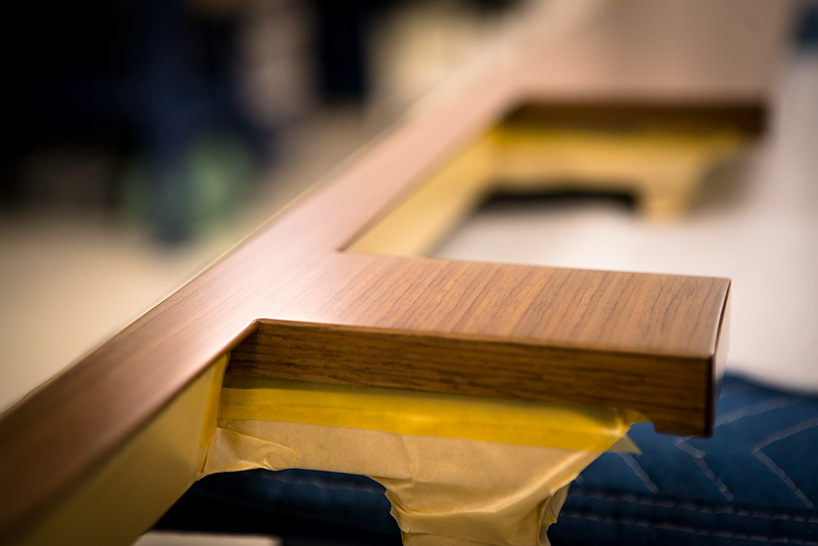
the high quality materials used would look at home in any residential setting
TF (continued): the next element — super important — is recline. what we noticed on a typical aircraft seat is what we call a ‘simple recline’. the backrest goes back, which is okay, but what can happen is that you can lose contact between your lower back and the backrest, and sometimes feeling like you’re sliding out of the seat. if you create a linkage that tips the seat pan a little below the hips, passengers can go into a sort of zero gravity position — maintaining that contact between the body and the seat. we also preserve the contact between the feet and the floor, which is another hugely important element of seated comfort. it takes pressure off the back of the legs. a lot of the unconscious movements made over a long flight come from the contact with the floor. the mechanism and linkage found in the ‘nuage’ seat is really delivering amazing comfort.
finally, another subtle change, but super important, is the tilting headrest. once you’ve gotten into the recline position, you can reach back and raise and adjust the headrest so it cradles the base of your head, so you’re fully supported from head to foot.
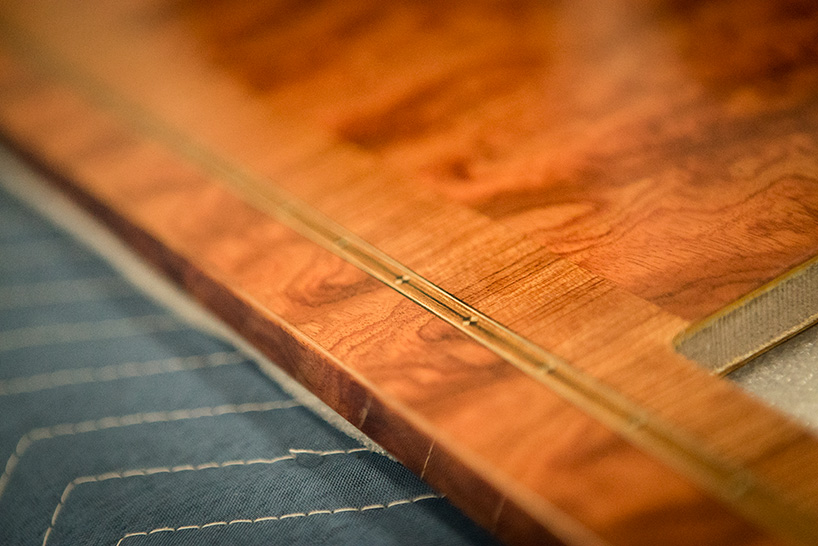
an unparalleled attention to detail is evident throughout the process
DB: what kinds of craftspeople are involved in the production of the ‘nuage’ seat, and how did their expertise help shape the design process?
TF: we have a really strong collaboration with not only the engineering team, but also the upholstery team that are manufacturing, hand-sewing and fabricating the seats. throughout the cabin — the wood cabinetry, the soft goods — every cosmetic finish is handmade and hand-fabricated for the global 7500 within bombardier. working with people who know leather, and know soft goods and fabrics, really helps steer the design team on how to maximize softness and flexibly so that the seat is not only beautiful, but also comfortable.

equipment used in the factory is monitored and kept track of at all times
DB: what are the material requirements that need to be considered in aviation design?
TF: when you’re designing for aviation, weight is of critical importance. there are special materials used in aviation that let us deliver high-quality wood finishes, and the high-quality leather and soft goods that passengers would expect to find in the home, but do it in a way that reduces weight. the wood cabinetry looks like highly-polished wood, and it is — the manufacturing process however uses thinly sliced veneer mounted onto a composite honeycomb panel. you get the richness of the wood, but an extremely rigid and lightweight construction that lets us have the best of both worlds. it looks beautiful — like something you’d find in a residential space — but is light enough for aircraft application. similarly, we have new wood or stone floors available — it’s very thinly sliced on an aluminum honeycomb structure that provides the weight that’s required for aerospace. however it delivers the richness of a stone or wood floor, just like you would have at home.
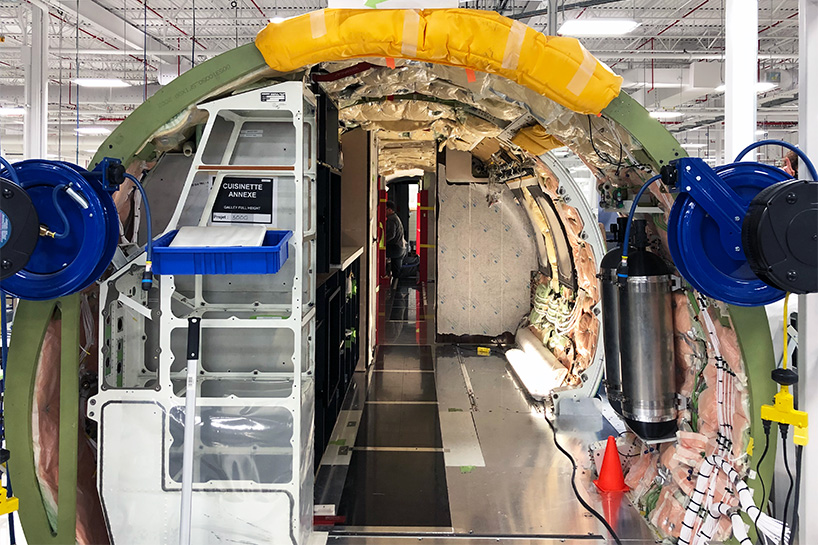
interiors are evaluated in a one-of-a-kind bombardier-designed test rig
DB: how does the design team balance space and storage in designing a small-scale environment?
TF: management of space is a really important element of designing for aerospace. in the galley for example, we worked with a team of flight attendants who in many ways knows the galley better than we do, to help us get the right balance of storage and working space. this balance is important so that we can have a very capable galley that not only holds what you need, but also allows the flight attendant to put together a meal for 15 people. in the cabin, the same applies. we want to provide storage for the things you might need during the flight, but also consider the idea of open space. sometimes, if you’re putting a briefcase down, an open space is better than a cabinet — you want to have it close to hand. like you see in an architectural space, sometimes luxury can be derived from openness. we try to balance all of that inside the aircraft cabin.
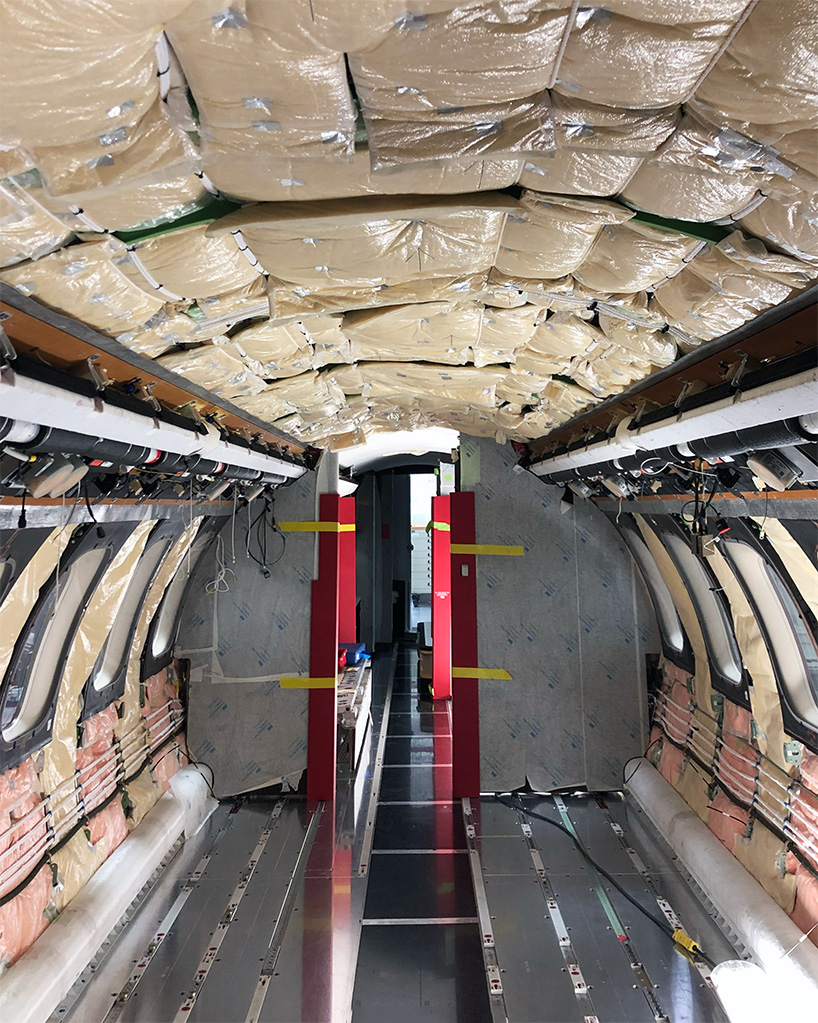
the rig replicates the conditions of flight related to airframe motions and loads
DB: what stages follow the purchase of a global 7500?
TF: after a client purchases an aircraft, there’s a process which we define as the completion of the aircraft — the selection of interior variations that they can choose for that particular aircraft. over the course of a few meetings with our design team and account management team, we work with the client to figure out the cabin layout. we discuss with them what their typical mission is, how it will be used, who will be on-board, if they will be flying overnight…these are the kinds of things that help us determine the correct layout from a floor plan point of view. we have special tools that allow customers to quickly consider different floor plan layouts and weigh the various merits of a particular configuration, whether it be an entertainment system, working, sleeping, or creating a capable office environment. all of those things need to be mixed together depending on that particular client. finally, there’s also the design and styling portions. at the laurent beaudoin completion centre, together with one of our interior designers, we help the customers select the colors, soft goods, materials, and form giving that is going to allow the aircraft to be an expression of the user.
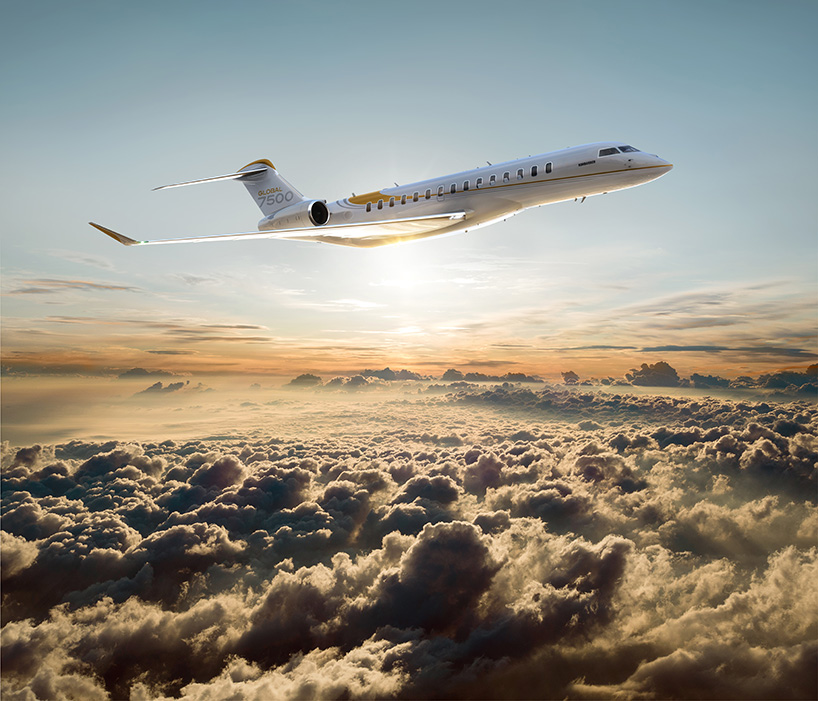
the global 7500 is on track for entry-into-service by the end of 2018
DB: what is the most rewarding part of your job?
TF: as a designer, what’s really rewarding about leading a design activity for an aircraft like the global 7500 is that it’s a series of individual design projects with individual design focuses, for example; seating, lighting, the design of modular systems, dedicated cabin suites and GUI design to name a few. everything requires a special focus and a special level of research to make sure you’re getting it right. each one is super rewarding on its own, and then to have them all come together to a unified whole, so that each piece is working together, is super exciting. now that we’re approaching entry into service and delivering those first aircrafts to our customers, it’s incredibly rewarding to be able to bring that to them and get their feedback. we’re really excited to get this aircraft into the hands of our customers!
